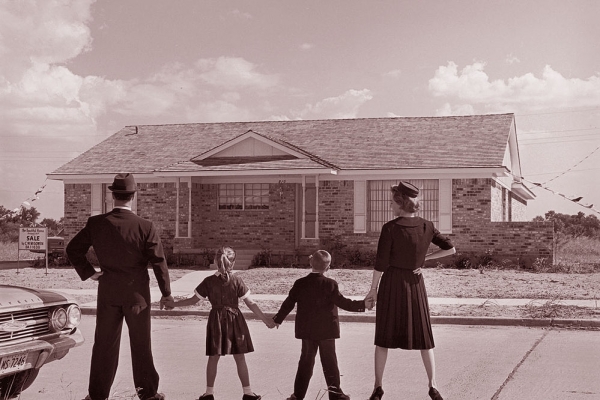 When the Second World War ended in 1945 the Europeans began shoveling themselves out of the rubble while simultaneously erecting their respective nanny-states. By contrast, the Americans set out on a shopping-spree that has yet to be matched in history. Never before had so many people been able to purchase so many affordable consumer products, and never before had there ever been such a variety; aided by the G.I. Bill, housing was a big part of this binge - and binge they did! The apple of their collective eyes involved a style of prefabricated housing that was called Ranch House, Cape Cod and Early American. Millions of them were built all across the country - and the financial model for these real estate developers came from a Long Island, New York man named William J. Levitt.
Attached is an article titled 15 Minutes with Levitt of Levittown.
The author Thomas Hine pointed out in his 1986 tour-de-force, Populuxe , that by the time the Eisenhower years rolled around, suburban houses were growing in size, as is typified in the attached article that was created to sell the plans for a 1,290 square foot piece of suburban splendor , that by the time the Eisenhower years rolled around, suburban houses were growing in size, as is typified in the attached article that was created to sell the plans for a 1,290 square foot piece of suburban splendor . Gone were the days of the "little boxes" that dotted the countryside throughout the late Forties and early Fifties; these newer and larger domiciles were built in the shapes of "U" or "L" and the most popular models were built in the "Ranch House" style with attached garages (gasp!). . Gone were the days of the "little boxes" that dotted the countryside throughout the late Forties and early Fifties; these newer and larger domiciles were built in the shapes of "U" or "L" and the most popular models were built in the "Ranch House" style with attached garages (gasp!).
"This is the new suburban America... It has developed since the Second World War. It is within hollering distance of a big city but has a definite will of its own. Its people are youngish and their numbers growing. To find out what goes on in such a community, PAGEANT MAGAZINE made a study of one typical postwar suburb: Levittown, Long Island. It has 82,000 people, fairly young; the town is 12 years old and still growing fast. What happens there [each year] is typical of the new American 'normal'":
• Average Income: $6,100.00
• Deaths: 304
• Births: 2,760
• Divorces: 101
• HS Graduates: 285
• College-Bound Graduates: 60
• Auto Accidents: 355
During the Second World War, millions of American military personnel passed through Los Angeles. Many were attracted to the simple domestic architecture, the smell of orange blossoms, Hollywood, the glorious weather - all of these or none of these, but many of them promised themselves that if they survived the war, this is where they would want to start their lives.
Many of these men fulfilled that promise, and they brought with them the government guaranteed housing loans provided by the G.I Bill - and a dusty, arid flat land just over the hill from Los Angeles called the San Fernando Valley began to grow as a result. By 1951, just six years after the war, two thousand building permits were issued for this area each month. After eight years of research, the National Retail Lumber Dealers Association and the Producers' Council, an organization of building materials manufacturers, have polished up all the known short-cut, dollar-saving methods in building, packaged them into an industry-wide program, and labeled them the 'four-inch module plan.'... The house is built on of three sections, each 16 x 24 feet, and bolted at floor, walls and roof. Wall joints are hidden by cabinets; by simply removing top and side cabinets, bolts can be loosened and the house readied for moving on trailers." | | |
|
|